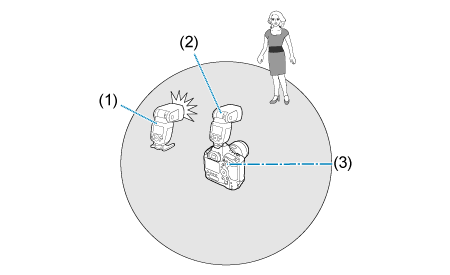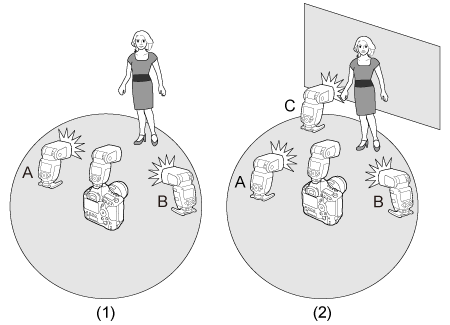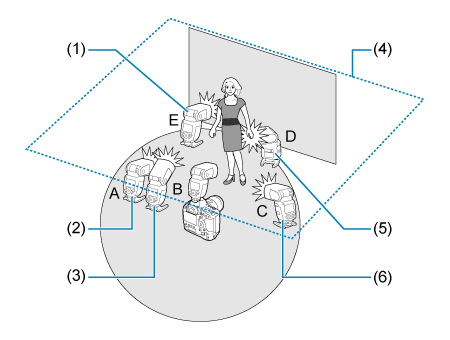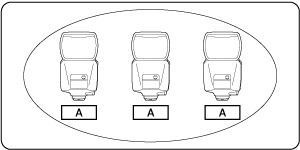Radyo Aktarımlı Kablosuz Flaşlı Fotoğrafçılık
- Pozisyonlandırma ve Mesafe Ayarı
- Radyo Aktarımı ve Optik Aktarım arasındaki fark
- Grup Kontrolü
- Belirli Fotoğraf Makineleri için Kısıtlamalar
Radyo aktarımlı kablosuz flaşlı fotoğrafçılığı destekleyen Canon Speedlite’lar kullandığınızda, birden fazla flaş ünitesinden kablosuz aydınlatma ile çekim yapmak normal E-TTL II / E-TTL otomatik flaşlı çekim kadar kolaydır.
Sistem, EL-1 (2. Sürüm)’in (gönderici) ayarları, kablosuz kumanda edilen Speedlite’lara (alıcılar) otomatik olarak uygulanacak şekilde tasarlanmıştır. Bu, çekim sırasında alıcılarla işlem yapma ihtiyacını ortadan kaldırır.
Pozisyonlandırma ve Mesafe Ayarı
-
Tek alıcı ile otomatik flaş ()

(1)
EL-1 (2. Sürüm)
(2)
EL-1 (2. Sürüm)
(3) Aktarım aralığı: Yaklaşık 30 m / 98,4 fit
-
Alıcı gruplarıyla otomatik flaş (, )
İki veya üç alıcı grubu ile E-TTL II / E-TTL otomatik flaşlı çekimler yapılabilir ve flaş oranı (flaş çıkış oranı) gerektiği gibi ayarlanabilir.

(1) 2 grup (A, B)
(2) 3 grup (A, B, C)
Önlem
Not
- Ürünle birlikte verilen mini standı kullanarak alıcıları kurun.
-
Her grup için farklı flaş modunda çekim ()

Bu, flaş modu ayarlarına sadece bir örnektir.
(1) E-TTL II
(2) E-TTL II
(3) Manuel flaş
(4) Tavan
(5) Manuel flaş
(6) Manuel flaş
Radyo Aktarımı ve Optik Aktarım arasındaki fark
Radyo aktarımlı kablosuz çekim, optik aktarımlı kablosuz çekime kıyasla biraz daha avantajlıdır. Örneğin, engeller daha az parazite neden olur ve alıcının kablosuz sensörünü gönderici üniteye doğru yöneltmek gerekmez. İşlevler arasındaki temel farklar şunlardır.
| İşlev | Radyo Aktarımlı | Optik Aktarım | |
|---|---|---|---|
| Aktarım mesafesi | Yaklaşık 30 m / 98,4 fit | Yaklaşık 15 m / 49,2 fit (iç mekan) | |
| Patlama grubu kontrolü | 5 gruba kadar*1 (A, B, C, D, E) |
3 gruba kadar (A, B, C) |
|
| Alıcı kontrolü | En fazla 15 | Sınırlandırma yok | |
| Kanal | Otomatik, Kanal 1–15 | Kanal 1–4 | |
| Kablosuz radyo kimliği | 0000-9999 | – | |
| Alıcı kontrolleri | Deneme flaşı | ○ | – |
| Modelleme flaşı | Evet*2 | – | |
| Tetikleme | Evet*3 | – | |
1-3: Fotoğraf makinesine bağlı olarak kısıtlamalar mevcuttur (*1: Belirli Fotoğraf Makineleri için Kısıtlamalar, Gruba Özel Flaş Modlarında Çekim, *2: Alıcı Ünitelerden Deneme Flaşı/Modelleme Flaşı Patlatma, *3: Alıcı Ünitelerden Uzaktan Deklanşör).
Grup Kontrolü
Patlama grubu A

Daha fazla ışık veya karmaşık aydınlatma gerektiğinde alıcılar ekleyebilirsiniz. Eklenen alıcılar için, daha parlak olmasını istediğiniz patlatma grubunu (A, B veya C) belirtmeniz yeterlidir.
Örneğin, üç alıcı, grubunu patlatmaya ayarlandığında bunların hepsi A grubundaki tek bir yüksek çıkışlı Speedlite olarak kontrol edilir.
Önlem
- Üç A, B ve C grubunu patlatmak için
konumuna ayarlayın. C Grubu, Speedlite’lar
ayarında olduğunda patlamaz.
- Patlama grubu C'deki ünitelerin doğrudan konulara bakması aşırı pozlamaya neden olabilir.
Not
- Stop sayısına çevrildiğinde 8:1 - 1:1 - 1:8 flaş oranının karşılığı 3:1 - 1:1 - 1:3 olur (1/2 stop’lu artışlar).
Belirli Fotoğraf Makineleri için Kısıtlamalar
Fotoğraf makinesine bağlı olarak, radyo aktarımlı kablosuz flaşla çekimde işlevler sınırlı olabilir.
-
2012 tarihinde ve sonrasında üretilen EOS DIGITAL fotoğraf makineleri
Flaşı 2012 yılında ve sonrasında piyasaya sunulan EOS DIGITAL fotoğraf makineleriyle kullandığınızda, flaş modu ve flaş senk hızında, vb. hiçbir sınırlandırma olmadan çekim yapabilirsiniz.
EOS 4000D/3000D, EOS 1500D/2000D, EOS 1300D ve EOS 1200D modelleri 2012’den sonra piyasaya sunulmuş olmakla birlikte, işlevlere ilişkin kısıtlamalar, 2011'e kadar piyasaya sürülen EOS DIGITAL fotoğraf makineleri ile aynıdır (Ayrıntılar için aşağıdaki açıklamaya bakın).
-
E-TTL uyumlu ve 2011 tarihinden sonra üretilen fotoğraf makineleri
Flaşı aşağıda listelenen fotoğraf makineleriyle kullandığınızda, E-TTL otomatik flaşıyla radyo aktarımlı kablosuz çekim yapamazsınız. Manuel flaşı () veya optik aktarımlı kablosuz flaşlı fotoğrafçılığı () kullanın.
EOS-1Ds, EOS-1D, EOS-1V, EOS-3, EOS Elan II/Elan II E/50/50E, EOS 300, EOS 500N, EOS 3000N/66, EOS IX, EOS IX Lite/IX7
Ayrıca, flaşı 2011 tarihinden sonra üretilen bir EOS DIGITAL fotoğraf makinesi veya EOS film kamerasıyla kullanırken aşağıdaki sınırlandırmalar geçerli olacaktır.
-
(1) Maksimum flaş senkronizasyon enstantane hızı bir stop yavaşlar.
Fotoğraf makinenizin maksimum flaş senk enstantane hızını (X = 1/*** sn.) kontrol edin ve maksimum flaş senk enstantane hızından 1 stop’a kadar daha düşük bir enstantane hızıyla çekim yapın (Örnek: X = 1/250 saniyede, radyo aktarımlı kablosuz flaşlı çekim, 1/125 ila 30 saniye aralığında mümkündür).
Enstantane hızını maksimum flaş senkronizasyon enstantane hızından bir adım düşürürseniz,
uyarı simgesi kaybolur.
- (2) Yüksek hızda senk çekimi yapılamaz.
- (3) Grup patlatma () kullanılamaz.
- (4) Alıcıdan modelleme flaşı () ve alıcıdan uzaktan tetikleme () kullanılamaz.
- (5) Bağlantılı çekim sırasında "alıcı fotoğraf makinesi" olarak kullanılamaz (). Yalnızca "gönderici fotoğraf makinesi" olarak kullanılabilir.
-